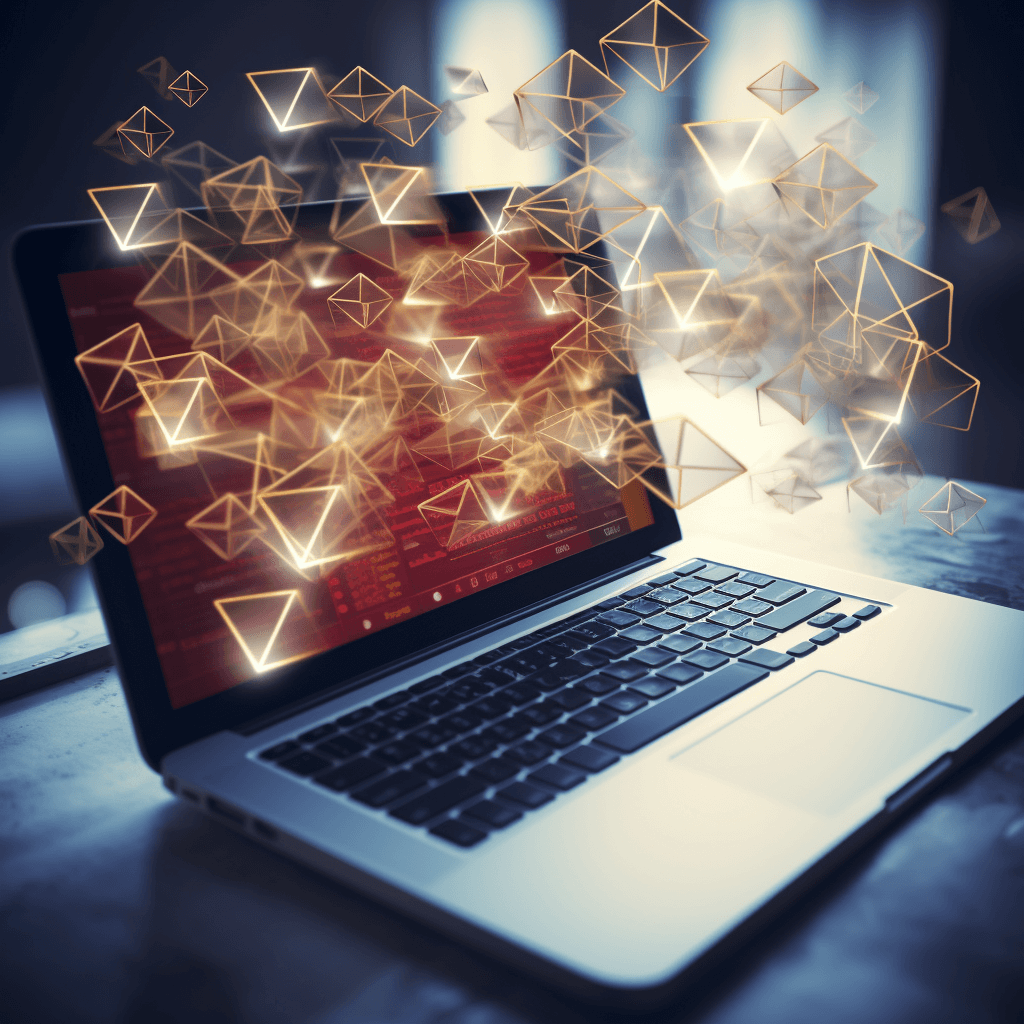Are your cold outreach emails disappearing into the abyss of the spam folder? Fret not, because in this article, we’re diving deep into the art and science of outbound email deliverability. But hey, before we move forward, have you recognized that Outbound Emails: A Must-Scale Tactic in the Digital Age? If not, now is your golden opportunity. We promise not to bore you with jargon or put you to sleep with technicalities. Instead, we’ll craft with a blend of humor, realism, and a touch of brilliance to challenge your email beliefs.
Goes Straight to Spam (And How to Avoid It)

Let’s dive right in and tackle a common dilemma: why do your carefully crafted emails often find themselves relegated to the dreaded spam folder? Picture this: you’re at a lively party, having a great time, when suddenly, you accidentally knock over the punch bowl. Is your email in the spam folder? It’s a bit like that party mishap. Here’s a closer look at why this happens:
- Generic Content: Imagine your email as a fine suit. If it looks like it was tailor-made for everyone and no one in particular, spam filters can spot it from a mile away. They have a nose for mass-produced content, just like a cat can instantly detect the elusive red dot from a laser pointer.
- Timing Misfires: While you may be a night owl who sends emails at 3 AM, your recipient might not appreciate their inbox being disturbed during their beauty sleep. It’s a bit like trying to impress someone with your dance moves while they’re trying to catch some Z’s.
- Bland Subject Lines: Think of your subject line as the trailer to a blockbuster movie. “Hello” or “Important Information” is like showing a trailer that consists of a blank screen. It doesn’t intrigue, captivate, or compel anyone to click. You need to be more Spielberg and less Snoozeville.
- Sloppy Email Body: Picture this: you show up to a job interview wearing pajamas with bed hair, and your resume is a crumpled mess. That’s how a sloppy email body comes across. Long paragraphs, chaotic formatting, and typos are like job interview no-nos for your emails.
- Boring Sign-offs: When you sign off with a robotic “Best regards,” it’s like ending a conversation with a monotone “Goodbye.” People want warmth, personality, and a sign-off that leaves them with a smile, not the impression that they just chatted with an automated customer service agent.
A Step-By-Step Guide to Inbox Triumph
Now, let’s transition from theory to actionable steps that can catapult your emails from the abyss of the spam folder to the coveted inbox. We’ve meticulously crafted a five-step roadmap to ensure your emails not only land where they should but also engage your recipients effectively:
1. Get Personal: Imagine your email as a warm, firm handshake – the kind that leaves a lasting impression. Address your recipient by name, and observe the magic that unfolds. Personalization isn’t just a buzzword; it’s the secret sauce that distinguishes your email from the rest.
2. Timing is Everything: Timing isn’t merely a detail; it’s a critical component of email success. Consider when your audience is most likely to be perusing their inboxes. Avoid the dreaded 3 AM curse when even nocturnal creatures are tucked in bed. Instead, aim for that sweet spot when they’re most receptive.
3. Craft the Killer Subject Line: Your subject line isn’t just an introduction; it’s your email’s first impression. Make it irresistible. Be witty, intriguing, or downright captivating. Your subject line should scream, “Open me now!” It’s the cinematic trailer that entices your audience into the main feature.
4. The Art of Email Body: Your email body should be a masterpiece of conciseness and engagement. Long paragraphs and convoluted text are akin to serving up a novel when your recipient expected a quick chat. Break up the content with subheadings, bullet points, and visuals, creating an inviting landscape that beckons exploration.
5. Sign Off with Style: Don’t underestimate the power of a memorable sign-off. “Stay awesome” resonates far more than the robotic “Sincerely.” Your sign-off is the last note in your email symphony, leaving a lasting imprint. Make it unique, warm, and unforgettable.
Pitfalls That Plunge You Into Spam
Let’s not forget the minefield of email marketing pitfalls that can send your messages straight to spam:
- Spray-and-Pray Approach
This approach involves sending the same generic email to a multitude of contacts in the hopes that something will stick. It’s akin to attempting to fit an elephant through a tiny keyhole – an endeavor bound for frustration. Personalization is your golden ticket out of this quagmire. Tailor your messages to individual recipients; it’s the magic wand that transforms your outreach from a cacophony of noise into a harmonious symphony of engagement. . It’s essential to look for solutions to prevalent issues in outbound email campaigns to address these common pitfalls effectively.
- Ignoring Engagement Metrics
Email marketing isn’t a one-way street where you send messages into the void and hope for the best. Don’t be oblivious to the invaluable feedback provided by metrics like open rates and click-through rates. These metrics are the compass guiding your email campaign. They reveal the effectiveness of your content, subject lines, and timing. By heeding their insights, you can adjust your strategy and keep your emails on the path to success.
- Neglecting the Unsubscribe Option
We’ve all encountered clingy individuals in our lives, and the same principle applies in the world of email marketing. Neglecting to provide an easy and straightforward way for recipients to unsubscribe is a surefire way to earn yourself a one-way ticket to the spam folder. Being clingy isn’t cute; it’s exasperating. Instead, respect your recipients’ autonomy and preferences. Offer an unsubscribe option that’s as hassle-free as the rest of your email experience. Not only does this demonstrate professionalism, but it also helps you avoid being inundated with spam complaints.
Real-Life Examples that Rocked the Inbox
Enough with the theory—let’s dive into some real-life success stories. These folks cracked the code and got their emails into inboxes:
The Persuasive Folks
Airbnb

Airbnb shines in the realm of personalized email marketing. They harness customer data, including search history and previous bookings, to curate personalized property recommendations and travel deals. In a noteworthy campaign, Airbnb crafted emails featuring properties aligning with users’ historical search patterns and budget constraints. The outcome was impressive, with a remarkable 100% increase in open rates and a solid 20% boost in bookings.
Spotify
Spotify adopts a personalized approach, tailoring emails to individual customers with music suggestions, playlists, and podcasts aligned with their listening habits. In a standout campaign, Spotify sent customers emails showcasing their top 5 most-listened-to artists, accompanied by a personalized playlist featuring new music from these artists. The result? A substantial 25% surge in open rates and a notable 10% increase in clicks to the Spotify app.

Netflix

Netflix is no stranger to the power of personalization, employing it to deliver laser-focused emails to customers. These emails contain recommendations for new movies and TV shows, drawing from users’ past viewing history. In a revealing study, Netflix found that personalized emails boasted a remarkable 50% higher open rate and an impressive 20% higher click-through rate compared to their non-personalized counterparts.
The Perfect Timing Pros
Airbnb

Airbnb employs data analysis to pinpoint the ideal timing for sending emails to its users. For instance, when a user recently browses a listing but hasn’t booked it yet, Airbnb may send a targeted email. This strategic timing increases the chances of success since the user is already engaged with the listing.
Uber
Uber also employs data-driven insights to enhance its email timing strategy. For instance, when a user has taken a break from using the Uber app, Uber seizes the opportune moment to send a well-timed email. This approach is designed to reconnect with users when they’re most receptive to rekindling their app usage.

Amazon

Amazon stands out as a maestro in data-driven email marketing. They employ data analysis to craft personalized emails for users, offering product recommendations tailored to individual preferences. What’s more, Amazon also leverages data insights to determine the optimal time to dispatch these emails.
These examples showcase how both companies and individuals have leveraged personalization and data analysis to make a significant impact in email marketing. By drawing inspiration from their successes, you can elevate your own email marketing efforts and achieve superior results.
Here are some additional practical tips for mastering email marketing:
- Craft Engaging Subject Lines: Your email’s subject line serves as the initial impression, so ensure it’s compelling and directly related to your email’s content.
- Segment Your Email List: Divide your subscriber list into distinct groups based on preferences and behavior, allowing you to send more tailored emails to each segment.
- Keep it Concise: Given people’s busy schedules, keep your emails succinct and focused. Avoid lengthy, rambling content that may deter readers.
- Incorporate Clear Calls to Action: Clearly outline what you want your recipients to do, whether it’s clicking a link, registering for a webinar, or making a purchase. A compelling call to action drives engagement.
- Continuous Testing and Optimization: Experiment with different strategies and approaches to discover what resonates best with your specific audience. Regular testing and optimization are key to ongoing improvement.
By incorporating these strategies into your email marketing endeavors, you can join the ranks of those who have achieved inbox success through personalization and data analysis.
Questions to Ponder Before You Hit Send
Before you embark on your next email campaign, ask yourself these critical questions:
1. Am I treating my recipients like humans, not just email addresses?
2. Have I perfected my timing to reach the inbox sweet spot?
3. Does my subject line make people curious enough to click?
4. Is my email body a breeze to read, or a daunting wall of text?
5. Can my sign-off bring a smile to someone’s face?

Finally
According to a study by Experian, personalized emails are 26% more likely to be opened and 6% more likely to generate a click-through. So, take the time to learn about your recipients and tailor your messages accordingly.
Master the art of timing. According to a study by HubSpot, the best time to send emails is on Tuesday at 10am. However, this may vary depending on your industry and audience. Experiment with different times and days to see what works best for you.
Craft emails so irresistible that even the spam filters are captivated. This means using engaging subject lines, compelling copy, and relevant calls to action. Avoid using spammy language and phrases, and make sure your emails are designed for mobile devices.
But we don’t expect you to take our word for it blindly. Put these proven strategies to work, and watch as your inbox triumphantly welcomes your messages. And should you ever encounter email challenges, remember this article as your trusty companion in conquering the intricacies of email deliverability.
Before you send that next email, keep in mind that it’s not just the content but also the way you present it that matters. Use a clear and concise writing style, avoid using all caps or excessive punctuation, and proofread carefully for any errors.
Happy emailing, and may your messages always find their rightful place in the inbox! 🙂











